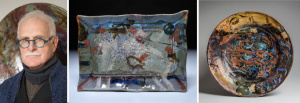Cranbrook Mourns the Passing of John Glick

Bloomfield Hills, Mich., April 7, 2017 – It is with heavy hearts that Cranbook mourns the passing of ceramicist John Glick (July 1, 1938—April 6, 2017). A 1962 graduate of Cranbrook Academy of Art (MFA, Ceramics), Glick went on to a career of great acclaim, creating ceramic works for dignitaries and the common man, always remaining a studio potter. “You could say I am hopelessly in love with bits and pieces of the making of pots,” he once said.
Known as “the people’s potter,” Glick operated Plum Tree Pottery in Farmington Hills, Michigan, from 1964 through 2016. He recently retired and sold the studio, and, with his wife Susie Symons, moved to California to be near family. Before they moved, Glick lent many of his “museum works”—the pieces that represent milestones in his career—to Cranbrook Art Museum for the 2016 retrospective exhibition John Glick: A Legacy in Clay. A gallery of work that appeared in the exhibition is viewable online here. True to his giving nature, select works from the exhibition will be donated to museum collections around the world. Glick’s work is represented by the Schaller Gallery in St. Joseph, Michigan.
Glick was widely recognized in his field. He was twice awarded the prestigious Louis Comfort Tiffany Award (1961 and 1972), received two National Endowment for the Arts Fellowships (1977 and 1988), and a Michigan Foundation for the Arts Governor’s Award (1977). He published numerous articles in the ceramics field and his work appears in more than thirty books on ceramics around the world. John Glick: A Legacy in Clay was published in conjunction with his retrospective at Cranbrook Art Museum in 2016.
Glick’s Plum Tree Pottery, since its founding, had also provided an assistantship program, mentoring thirty-three young ceramicists. Many of these artists have gone on to their own careers in ceramics. Glick also conducted many workshops for potters of all ages over the years, further fostering his connection with the local community and the wider ceramic arts world.
“The potter who finds life in his work finds it daily in small glimpses, and perhaps these are the successes as much as anything,” Glick has said. “For example, shapes evolve guided by forces apparently outside my control. This is instinct, intellect and openness to change fusing, into what I think is the most positive force behind any potter’s approach: evolution or growth…. I cannot show one piece and say ‘this speaks for my beliefs in clay.’ I am attracted to simplicity, as well as complexity: my work continually reflects my re-examination of how these two poles can coexist..or not, in a given series.”
A memorial to celebrate John Glick’s life will take place in Michigan early this summer.


